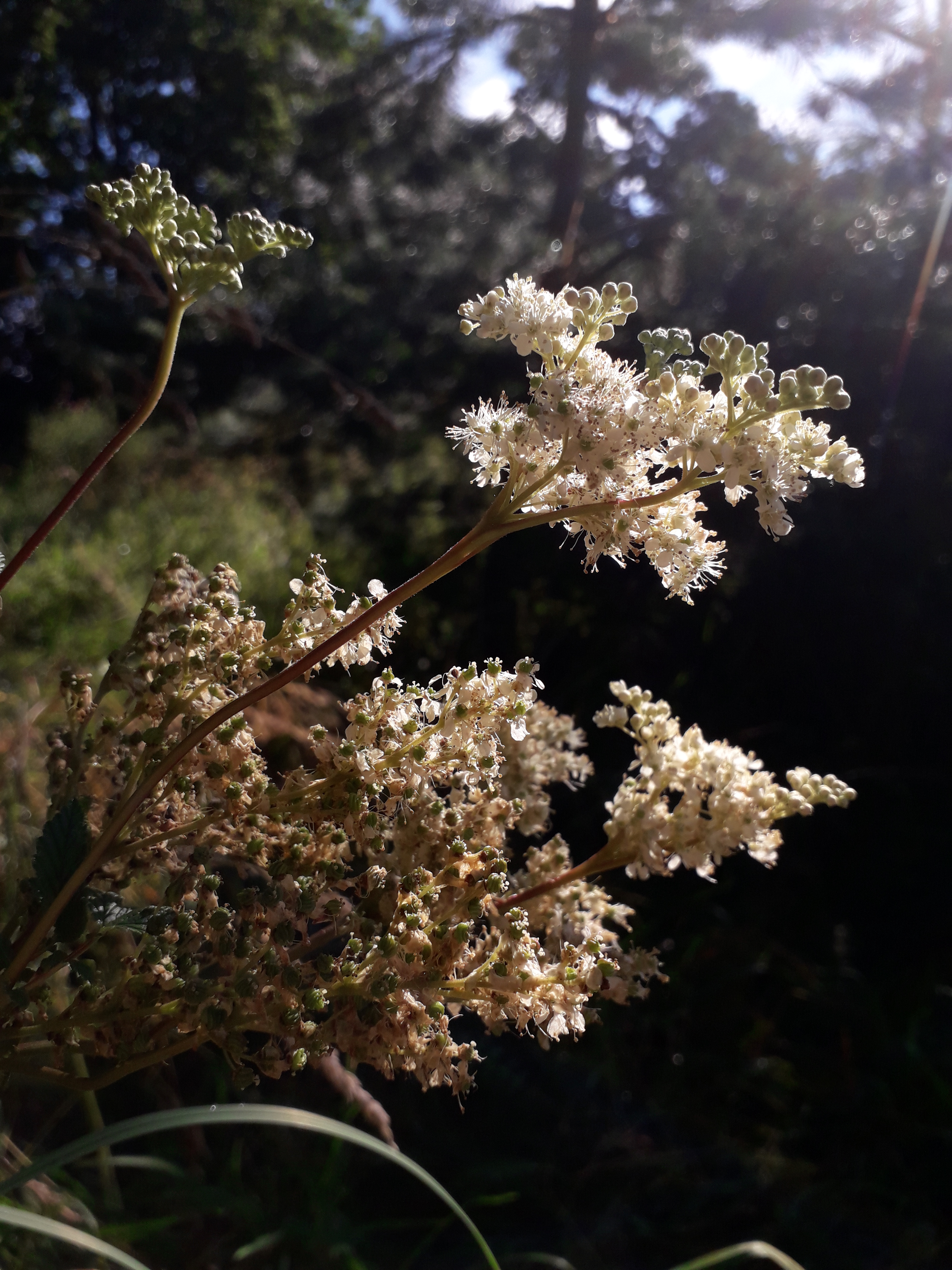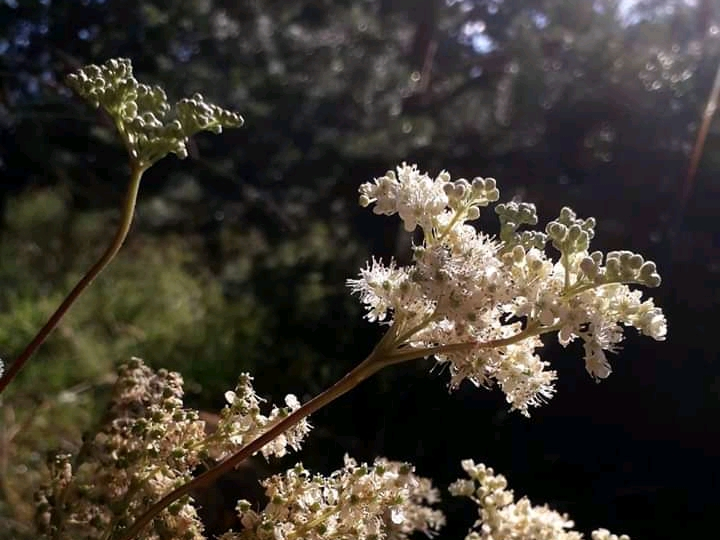Meet, Meadowsweet.

Meadowsweet is a perennial herb of the rose family that is native throughout most of Europe and Western Asia. It has been introduced and naturalised in North America. You can find it flowering from June to September in wet habitats, such as ditches, damp woodlands and meadows, along river banks, and beside ponds.
It has deeply veined leaflets held on arching stems that are topped with fluffy sprays of creamy-white, five-petaled flowers, each with over twenty protruding stamens. These flowers have a very strong, sweet scent. The flower sprays can be up to 25cm in width.
It plays an important role in ecosystems. The larvae of several moth species, including Emperor, Brown Spot Pinion, Grey pug, Hebrew Character, Lime-speck Pug, Mottled Beauty, Lesser Cream Wave, and Satellite, use it as a food plant. The flowers also attract a wide variety of other insects, including pollinators such as bee, butterfly and hoverfly, whilst the seeds provide food for birds.
This delicate, sweetly scented flower has many names. Its Latin name is Filipendula ulmaria. The genus name, Filipendula, is an amalgamation of ‘filum’ meaning thread, and ‘pendulus’, meaning drooping – which is thought to refer to the root tubers which hang together by threads. It’s species name, ulmaria, comes from the Latin word ‘ulmus’, meaning elm. This is due to the shape of the plant’s leaves.
Chaucer, in ‘The Knight’s Tale’, called it Meadwort, or Medwort, and named it as one of the fifty ingredients included in the drink, ‘save’. It has the name Bridewort because it was both strewn in churches for festivals and weddings, and was also used for bridal garlands. Names such as Queen of the Meadow, Pride of the Meadow, Lady of the Meadow and Meadow Queen were given to it because of the way in which it can dominate a damp low-lying meadow. It is also known as Meadow-wort, Bittersweet, Dollof, and Meadsweet. It’s Gaelic names include Ius Cuchulainn, and Rios Cuchulainn, as Irish legend tells of how the legendary warrior, Cuchulainn was treated with Meadowsweet baths in order to cure his uncontrollable rage and fevers.
There is other folklore connected with Meadowsweet, as well. In Welsh mythology, the magicians Math and Gwydion created a beautiful maiden out of the flowers of Meadowsweet, Broom, and Oak. She was made for one purpose only – to be a wife to the hero, Lleu Llaw Gyffes, who had been placed under a tynged by his mother, Arianrhod, that he would never have a human wife. She was named Blodeuwedd, meaning ‘flower-faced’. The story goes that Blodeuwedd took a lover, Gronw Pedr, and together they conspired, unsuccessfully, to murder her husband. As punishment, Blodeuwedd was transformed into an owl, to be forever shunned by the denizens of the daylight hours.
And Gwydion said to Math, when it was Spring: “Come now and let us make a wife for Llew.”
And so they broke broad boughs yet moist with dew,
And in a shadow made a magic ring:
They took the violet and the meadow-sweet
To form her pretty face, and for her feet
They built a mound of daisies on a wing,
And for her voice they made a linnet sing
In the wide poppy blowing for her mouth.
And over all they chanted twenty hours.
And Llew came singing from the azure south
And bore away his wife of birds and flowers.
By Francis Ledwidge
Other folk beliefs include the plant’s use in love spells and potions. When strewn about the house it is said to bring peace, and the scent of Meadowsweet is said to cheer the heart. If you gather it on Midsummer’s Day, Meadowsweet can give information regarding thieves – just place the Meadowsweet on water. If it sinks, the thief is a man; if it floats, it is a woman. Garlands of Meadowsweet worn at Lammas are said to join the wearer with the essence of the Goddess.
In addition to this, Meadowsweet is also a bringer of courage. In Russian folklore, Kudryash, the bravest knight in his village, one day became terrified that death stalked him. He could no longer fight and when a band of thieves came to the village, Kudryash was too scared to help. He was so ashamed of his cowardice that he fled to the river, intending to drown himself, but out of the water emerged a beautiful maiden who gave him a garland made out of Meadowsweet flowers. She told him that he would be unharmed if he wore the garland into battle. He returned to the village, wore the garland and defeated the thieves.
Other folklore claims that where Meadowsweet grows there are no snakes, which can also mean, therefore, that there is no evil present.
If you have a lot of it growing, Meadowsweet is a lovely plant to harvest for use. The green parts have a similar aromatic flavour to the scent of the flowers, and it can be included in jams and stewed fruit to add a pleasant almond taste. It has traditionally been used to flavour vinegar, wine, beer, and mead – which is the origin of many ‘mead’ related names. The 17th century English botanist, physician and herbalist, Nicholas Culpeper, recommended that a leaf of Meadowsweet should be added to a cup of claret wine, to give it a ‘fine relish’.
Today, Meadowsweet is one of the thirty herbs and spices that is added to the popular Norfolk punch cordial drink. This is made following an authentic medieval recipe that was originally made by the monks of Norfolk.
Historically, it was a popular strewing-plant, commonly scattered over floors in order to keep rooms sweet smelling.
The leaves and floures of Meadowsweet farre excelle all other strowing herbs for to decke up houses, to strawe in chambers, halls and banqueting-houses in the summer-time, for the smell thereof makes the heart merrie and joyful and delighteth the senses.
John Gerard, 16th Century botanist
It was a particular favourite of Queen Elizabeth I of England, who liked it to be used in her chambers. Having plants strewn over the floors isn’t really acceptable in a modern house, but Meadowsweet can be dried and included in pot pouri for a similar affect.
In addition to this, the roots of Meadowsweet produce a black dye and the leaves a blue pigment, which makes it perfect for those who wish to use natural materials for their art or craft work.
Meadowsweet is possibly most well known for its medicinal uses.This is mainly because it contains salycilic acid, a compound that is similar to Aspirin. As such it has pain-killing properties. Salicylic acid was first produced in 1838 by the Italian scientist, Rafaele Piria, from the flowerbuds of Meadowsweet and from the bark of the Willow tree (Salix alba). The name, ‘Aspirin’ that was given to acetylsalicylic acid after it was created by the company Bayer in 1899, actually comes from the old botanical name for Meadowsweet – Spiraea ulmaria.
It can be steeped in water to make a relieving tea, useful for managing aches and pains, particularly for those suffering from colds and flu. It can, though, be a little harsh on the digestive system. The plant’s digestive effects mean that it has traditionally been a go-to herb for those suffering from indigestion, flatulence, and diarrhoea. It protects and soothes the mucous membranes of the digestive tract, reducing excess acidity and alleviating nausea. It can also be used as a treatment for heartburn, hyperacidity, gastritis and peptic ulceration. Salicylic acid has anti-inflammatory properties, making it an effective treatment for rheumatic pain.
The tannins and mucilages found in Meadowsweet appear to limit some of the adverse effects common to the salicylates – such as those that can cause gastric bleeding (Aspirin can cause gastric ulceration). Care should still be taken with the use of Meadowsweet, however, as salicylic acid also acts as a blood thinner. This can cause internal bleeding, and prevents wounds from clotting. Use should be halted a week before admission to hospital for surgery.

If you’d like to find out more, these are the sites that I collected my information from:
This post is for 365 Days Wild, day 65.





Fascinating. It just goes to reiterate that fact that we don’t know what we know. There is so much shared knowledge that has to be learnt and relearnt and is not passed on as it used to be.
LikeLiked by 1 person
Definitely. There’s a great website that I found a while back https://www.plant-lore.com, that is collecting all of the bits of plant knowledge held by contributors. It’s a fascinating collection. If information isn’t shared, it’s lost. 💚 Thanks for reading, Peter. 😊
LikeLiked by 1 person
Amazing and varied information about a single plant. Great photos and a fascinating read.
LikeLike